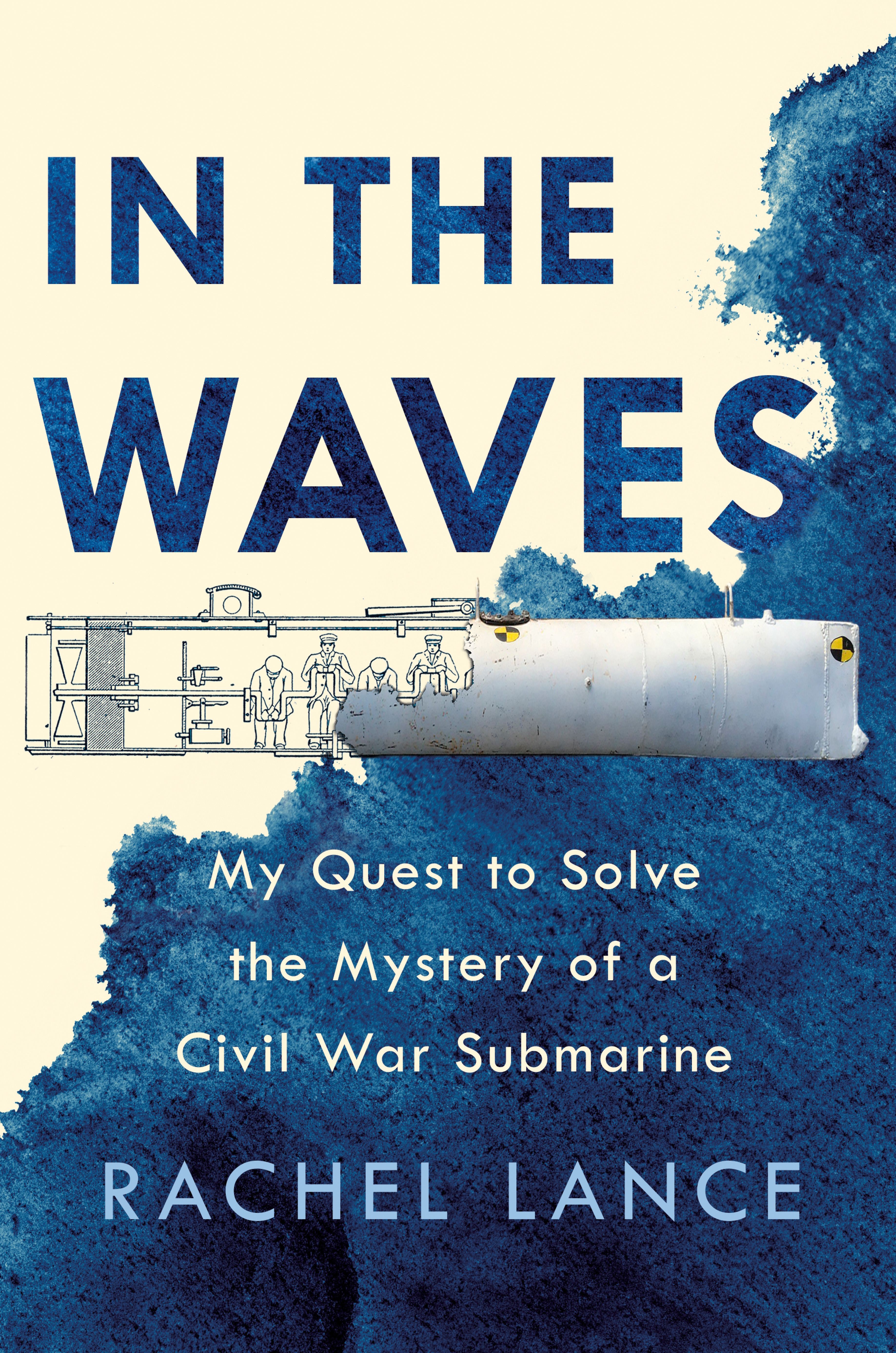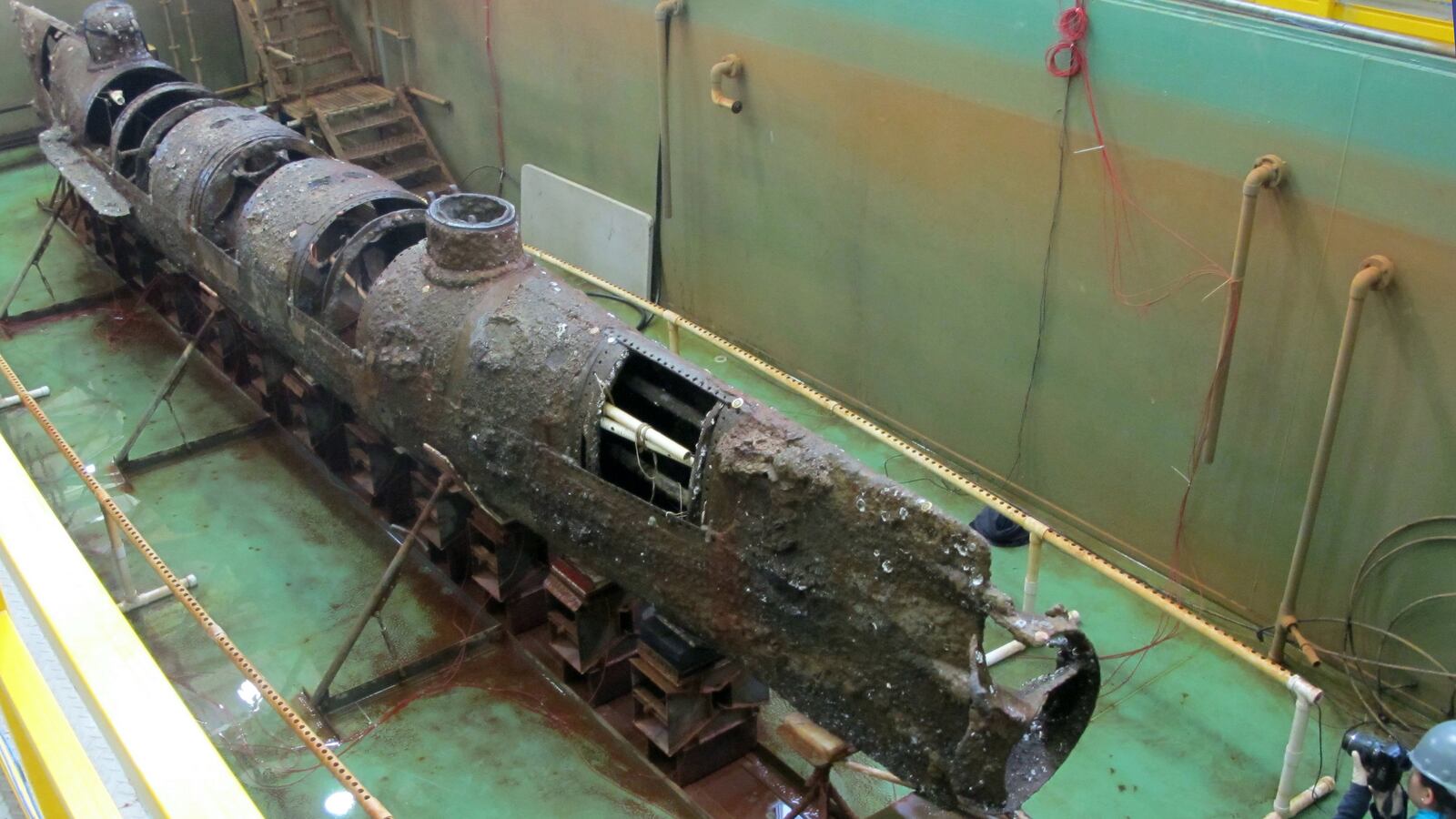The dark hull of the submarine rose a few inches above the waterline, belying the impressive metal body submerged below. Pale moonlight glinted off the quiet ocean as small waves lapped rhythmically against the hull. The submarine was 40 feet long, cylindrical down most of her slim length, but with a tapered, wedge‐shaped bow and stern that hinted at how quickly she could slice through the water. Two narrow, oval conning towers rose above the peak of the rounded hull, and a double row of small, glass deadlights punctuated the surface between them. The deadlights, with their thick, imperfect, handmade glass, provided the only means for the moonlight to pierce the submarine’s bulk, and the only sign that there might be a crew within.
The HL Hunley was lying in wait to the east of Charleston Harbor, off the coast of South Carolina. The submarine had been there for months, practicing for her crucial mission and waiting patiently for flat seas.
Her bow carried the true source of her threat. A spar made of wood and metal was bolted securely to a pivot on the bottom corner of the boat’s leading edge, and at the far end of this spar was a copper cylinder the size of a keg: the boat’s torpedo. The torpedoes of the time were simple stationary bombs, very different from the modern, independent devices that can propel themselves through the water from a great distance. To complete her mission the Hunley would need to approach her target closely, then use this spar to press the charge directly against the side of her enemy’s hull. As the submarine bobbed slowly in the waves, the lethal orange cylinder bobbed with it.
The propeller on the long submarine began to spin into motion. Its three arced blades cut through the cold February water and accelerated the sub in the direction of the open ocean. The tide was beginning to turn, and the outgoing current would further speed the Hunley toward her target.
On the deck of the Union ship USS Housatonic, the sailors gazed out over the flat seas of the Atlantic. Confederate torpedoes, later re‐ named “mines” by a future generation of warriors, lay peppered throughout the waters of Charleston’s harbor, drifting idly on weighted tethers anchoring them to the ocean floor. The Housatonic had reached an uneasy détente with these hidden underwater bombs by staying in the shallows outside the harbor’s mouth, but the Confederates were always trying new ways to attack. There had been reports of small, stealthy boats armed with charges on spars, and even some reports of mysterious boats that could supposedly travel completely under the water. The Housatonic was just one of many Union ships that had been prowling the waters outside Charleston for months, and tonight, like every other night, the cool air was punctuated by the sounds of Union artillery gradually chipping away at that city’s stately stone buildings. She tugged gently against her anchor as the tidal currents shifted and pulled her seaward. The Hunley swam closer.
It took hours to reach the ship.
The Hunley approached the hulking wooden mass of the Housatonic, and the comparatively tiny submarine began to pick up speed. A sailor on watch spotted the narrow sliver of the dark metal hull exposed above the surface of the water and alerted the other sailors on board, but submarines were new technology and the men did not yet understand the deadly shape in the water. For a few brief minutes speculation ran wild among the crew, and the sailors did nothing as they comforted themselves that the dark shape was merely a porpoise coming to play near the ship. They realized the approaching danger too late, and the crew scrambled for firepower, any firepower, that could be trained to hit the oncoming object. The submarine remained undeterred.

HL Hunley pressed her torpedo snugly against the Housatonic’s side. One of the three thin metal rods protruding from the leading face of the bomb depressed slightly against the wooden hull. The fragile wire holding the rod precariously in place snapped, freeing the coiled and waiting energy of the compressed spring that was firmly wrapped around its body. As the spring rapidly expanded to its natural shape, the metal rod leapt backward in response and smashed against the thin wall of the compartment that was nestled in the back of the trigger. Inside the compartment were two small caps filled with mercury fulminate. The simple, elegant chemical was inherently unstable, dying for the slight nudge that would propel it into a cascade of cathartic release.
Any fire is a release of energy. Chemicals and materials in one state leap to a more stable, lower‐energy state, like a rock rolling down to a lower‐energy state at the bottom of a hill. The energy released from the reaction takes the forms of heat, sound, and light. An explosion is a similar reaction but pushed into higher speed.
The rod impacted the thin compartment wall directly opposite one of the unstable mercury fulminate caps, and the boulder was shoved violently off a massive cliff.
Electrons began to transfer. The nitrogen, oxygen, and carbon of the fulminate rearranged, and the potent chemical reaction inside the caps released fiery heat and energy into the surrounding black powder. The powder caught next, each small granule beginning to burn, release heat, and pass the explosion to its neighbors like trees in a dense forest caught in the tempest of a wildfire. The granules of black powder converted one at a time into a mass of extraordinarily heated gas, trapped in the thick copper casing of the tightly sealed torpedo until enough fiery, pressurized gas accumulated to muster the power to tear and destroy the metal.
The copper ripped open, sending jagged shards peeling backward over the Hunley’s spar, and releasing the fearsome pressures of the powder into the water and against the wooden hull of the Housatonic.
A spray of shattered wood planks burst upward from the deck of the ship. The submarine had hit her target, triggering her massive black powder payload directly against the stern and punching a lethal blow through its underbelly. The force of the blast rippled through the entire ship, and even the sailors at the bow nearly 200 feet away instantly understood that their vessel would soon be on the ocean floor.
As the crew scattered to save themselves, the metal hull of the submarine silently disappeared from concern. Those in Charleston awaiting the return of the Hunley, hoping to celebrate her successful mission, never saw her again.
One hundred and thirty‐six years later, in 2000, in a massive custom‐built water tank with a cathedral‐like crown of metal support joists, archaeologists clad in protective coveralls and wearing respirators sorted patiently and painstakingly through the muck and silt that had slowly filled the hull of the submarine as it had lain waiting on the bottom of the ocean floor. Hunched over the curved surface of the boat and removing silt one small scoop or chunk at a time, they revealed bone after bone.
Accounts of the Hunley’s sinking had assumed horrific scenes of the men trying to claw their way through the thick iron hatches, or huddled in the fetal position beneath the crew bench in their agony. Sinkings of modern submarines always resulted in the discovery of the dead clustered near the exits in their desperate efforts to escape their cold metal coffins, because to sit silently and await one’s own demise simply defies human nature.
The crew of the Hunley, however, looked quite different. Each man was still seated peacefully at his station.
The lost crewmen of the HL Hunley are often painted as gilded martyrs, noble and titanic warrior‐champions who squeezed voluntarily into a narrow tomb for the patriotic reasons of home and country. No other explanation is ever offered, or even made to seem necessary, to explain their presence in the doomed submarine. In reality, however, the simple mechanical device was the product of the cumulative effort of many people working together to accomplish their own varied and disparate goals, and something far more complex than pure nobility motivated these men to volunteer themselves. The final mission took place even after two crews had already been killed by the vessel, and at first everything seemed to go according to plan: the mechanical beast of the submarine behaved exactly as she was designed to behave, they reached their target, the bomb exploded. Yet somehow the victorious little boat also profoundly failed, because every man of the crew died without a single external sign of struggle.
For decades since her recovery people have wondered about the final mission of the Hunley, how the crew died, how they ended up trapped in a silent grave buried beneath the sea. For decades people have wondered, in a question imbued with more than one layer of meaning: How did these men get here?
About one‐quarter of the world’s countries now boast a military submarine fleet. Hundreds of the vessels of this “silent service” continuously prowl the world’s oceans under the cover of salted waves. They carry untold thousands of sun‐deprived sailors for months at a time, and transport without detection a portion of the world’s nuclear arsenals.
And it all started with the Hunley.
From In the Waves: My Quest to Solve the Mystery of a Civil War Submarine by Rachel Lance, published April 7 by Dutton, an imprint of the Penguin Publishing Group, a division of Penguin Random House, LLC. Copyright © 2020 by Rachel M. Lance.






